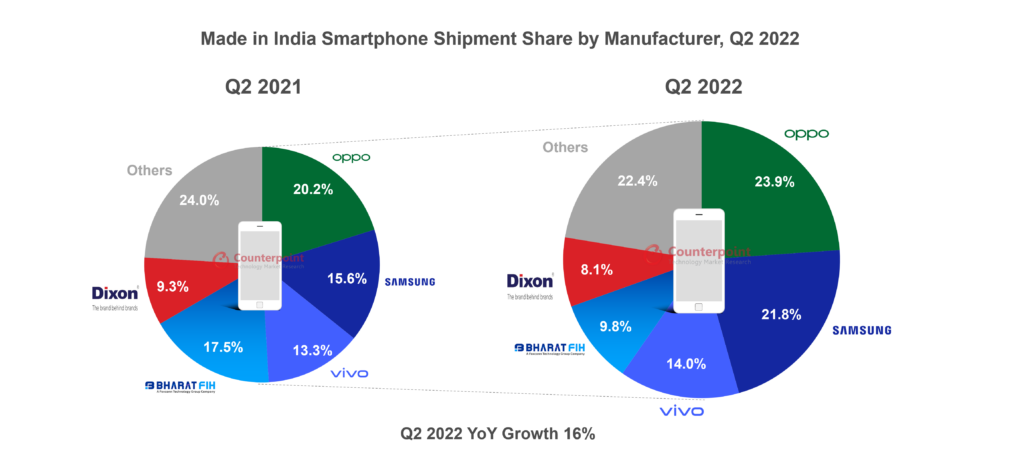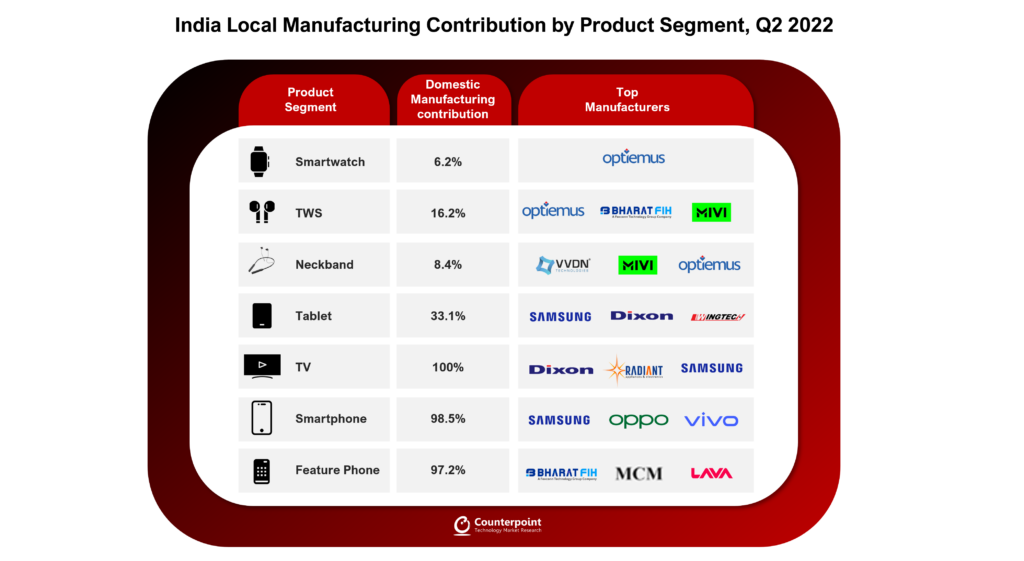
According to the most recent data from Counterpoint’s Made in India service, shipments of “Made in India” smartphones increased 16% YoY in Q2 2022 (April to June) to reach over 44 million units. In order to achieve the requirements for PLI incentives, the enterprises pushed for better output during the first quarter of the new fiscal year. In Q1, 2022, global smartphone chip shipment fell 5% year-on-year.
The local manufacturing push affects various product areas, including CIoT. The Indian government’s many PLI programmes have had a good influence, and we noticed an increase in local manufacture of smartwatches, TWS, neckbands, and tablets.
Optiemus has 75% of its smartwatch shipments made in India. Optiemus, Bharat FIH, and Padget are leading TWS brands. In the neckband category, VVDN and Mivi have a 90% market share. In tablets, Wingtech, Samsung, and Dixon are top players, while Dixon, Radiant, Samsung, and LG have a 50% share of Made in India shipments.

Counterpoint research says that the Indian government’s focus on building a semiconductor ecosystem will lead to a fast-growing environment for making electronics and coming up with new ideas. By doing this, it hopes to attract manufacturers and investors and strengthen its place in the global value chain.

- OPPO led smartphone shipments made in India with 24%, followed by Samsung.
- Lava had a 21% share of India-made feature phone shipments.
- TWS dominated domestic wearable production with 16%, followed by neckbands and smartwatches.
- Padget Electronics (396% YoY), Wistron (137% YoY), and Lava (100% YoY) shipped the most smartphones during the quarter.
Commenting on the local manufacturing ecosystem, Senior Research Analyst Prachir Singh, said,
The Made in India smartphone shipments grew as compared to last year. During the quarter, we witnessed increasing investments in the Indian manufacturing ecosystem with new plants being set up as well as existing ones being expanded. Recently, OPPO announced the Vihaan initiative under which it plans to invest $60 million in the next five years to empower the local supply chain.
Samsung also increased its manufacturing with the premium segment smartphones, especially the Galaxy S series. Going forward, the upcoming festive season will further drive the Made in India shipments due to the expected increase in local demand.
On the Indian government’s focus, Research Analyst Priya Joseph said,
The government aims to make India an electronics manufacturing hub in the next four to five years. In its vision document released earlier, the government considers consumer electronics segments like smartphones, laptops, tablets, TVs, TWS and electric components as among the most promising for India’s transformation as an electronics hub.
To help drive more initiatives under the themes of Make in India and Digital India, the government, in its last budget, pushed the total allocation to $936.2 million. This step not only aims to incentivize India-based manufacturing but also catalyse investments in the sector to support job creation, ease of doing business, import reduction and export promotion.
